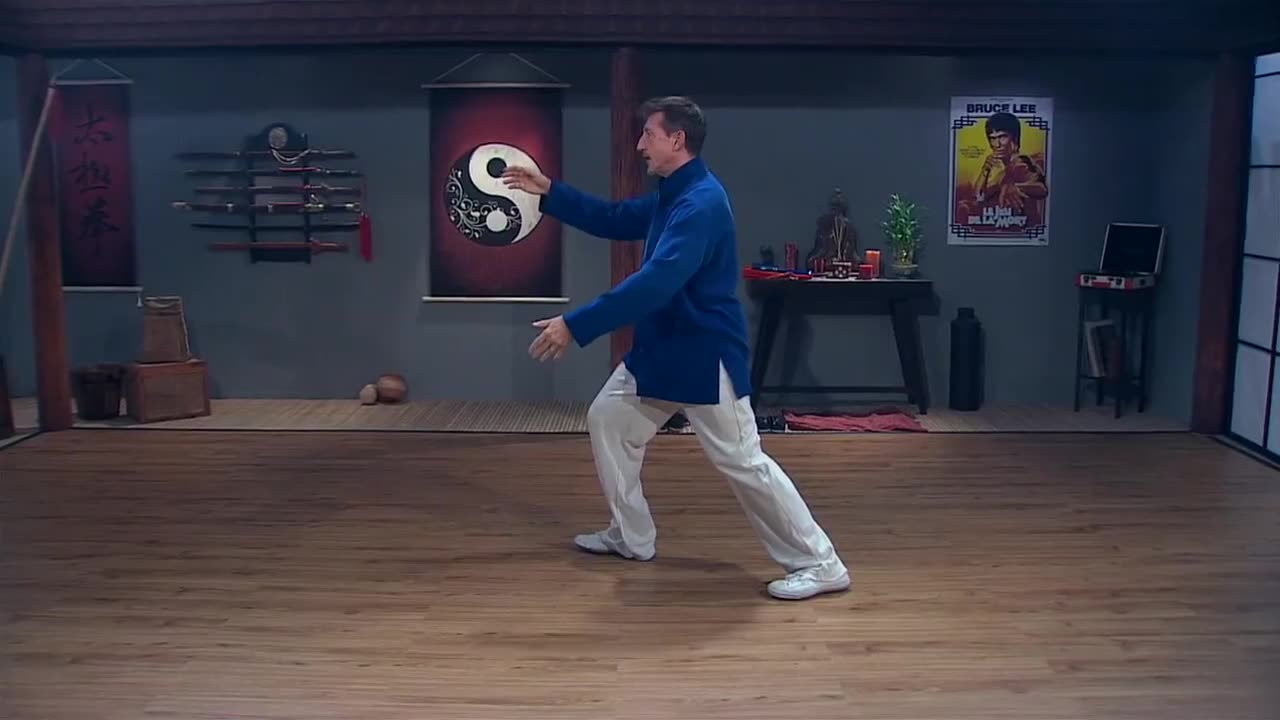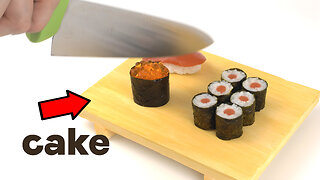Premium Only Content

02. Harmony Is The Ultimate Goal
In this course, we’re learning movements of the Yang style 40 form. This
lecture begins to introduce the actual moves of the form. We’ll learn the
first movement of the form, which sets the stage for all the movements to
follow. Then, we’ll move on to a compound move, breaking it down into
parts. Finally, we’ll close with a look at the tai chicentric concept of yin
and yang.
The Commencing Form
● The first movement of the routine is called “the commencing form”
or “the first move.” Another name for this movement is “opening
the door.”
● In this movement, the waist and hips are stable and point straight
forward. Start with the feet together, knees slightly soft, hands
relaxed by your sides. Shift the weight down into the right foot,
emptying out the left foot. Step out approximately hip width with
the left, then center the weight evenly over both feet. Raise both
arms, palms down, until they are even with shoulders. Then, drop
the elbows and let them pull the hands down until the hands line
up with the hips—palms still down, fingertips pointing forward.
Grasp the Bird’s Tail
● The next move is “grasp the bird’s tail.” It’s a compound move,
with many sections, but we can break it down.
● Shift the weight to the left foot and pivot to the right, turning the
right foot out 45 degrees. Sink down as you shift the weight to the right foot and circle the arms around to a holding-the-ball posture
with the right hand on top.
● Face front, step the left foot to the front and shift the weight into a
bow step with the left foot forward. The left hand expands outward
(palm facing in) into “ward off,” with the left hand down by the hip.
As you complete the ward-off position, turn the body to the right
and look toward the right.
● Turn slightly back to the left; after a small shift back onto the right
foot, shift forward and step up with the right foot as you circle the
hands into a holding-the-ball position, left hand on top. Step to the
right side with the right foot, form a bow step, and expand the right
arm into a ward-off position. The left hand follows the right hand,
ending with the fingers just below the right wrist.
● Turn slightly to the right and rotate both arms; the right arm rotates
in (palm facing down), and the left arm rotates out (palm facing
up). Sink the elbows and turn the waist to the left, carrying the
arms along to the left side; this is “roll back.” Complete an arc, or
“fish-tail,” by turning the waist back to the right and rotating the
arms again. This time, the right arm rotates out—palm facing in—
and the left arm rotates in—palm facing forward; then, place the
left palm against the right wrist.
● Shift straight forward to a right-foot-leading bow step, expanding
the ward-off position as you go.
● Slide the left hand over the top of the right wrist and separate the
hands to shoulder width. Shift the weight as much as possible to
the back foot, drawing both hands in and downward to hip level.
Shift the weight forward into a bow step one last time, pushing the
hands upward and forward. Remember to keep the arms rounded
in the final position.
The Marriage of Yin and Yang
● The phrase taiji chuan is made up of three individual words:
tai, meaning “very big” or “supreme”; ji, meaning “central” or
“ultimate”; and chuan, usually translated as “fist” but more
generally understood to mean “martial art system.” In China, tai
chi is commonly revered as the highest level of kung fu.
● But these words also have other meanings in Chinese culture. The
phrase tai chi refers to the philosophy of balance and harmony. It is
the supreme ultimate of life—the highest ideal that a human being
can aspire to, becoming one with the way of nature. Chuan is a
word that has many subtle meanings. The ideogram, or Chinese
character, shows a hand within a hand. A secret method hidden
within an outer art form.● Tai chi is the marriage of yin and yang, including heaven and
earth and inner and outer. In this course, we will have a chance to
learn the inner principles, once considered “secrets,” that exist as
complements to the basic level of those principles, which in tai chi
are called outer or external principles.
● What is the secret that this art called tai chi chuan teaches us? It
is that the attainment of harmony is a process and that maintaining
harmony is done by a daily practice. As mentioned earlier, we’ll
work through this process in a series of 40 movements.
● The important thing to remember is this: All the forms, no matter
their length, are simply tools for rehearsing the guiding principles
of tai chi—the step-by-step method of achieving, maintaining,
or restoring harmony in your life. We do it as a choreographed
routine because—in addition to gaining physical health benefits—
we want to experience the philosophy with our whole body. The
principles must work in three dimensions, or they are no more
than an interesting theory. Forty movements gives us a nice block
of time to practice these principles every day.
● Throughout this course, we will look into the guiding and
organizing principles of tai chi so that we can better explain how
and why tai chi so consistently and effectively delivers its lifechanging benefits: improved physical and mental health, longevity,
martial skill (for those who wish to pursue that aspect), success
in achieving your dreams and goals, and the ability to become a
more compassionate, centered, and peaceful person.
● When we consider diving headlong into the study of the inner
principles of tai chi, we might ask, “Why? What will harmony
give me?” The answer is simple: When you are in balance and
harmony, everything in life just works better. The more balanced
your life becomes, the smoother and more effortless it feels. But
when your life is out of balance, that’s when things begin to fall
apart. That’s when we struggle and age. And the farther out of
balance we become, the more that struggle takes its toll on us.
-
 17:06
17:06
Professor Nez
9 hours ago🚨BREAKING: Elon Musk to BUY MSNBC!? Dems STUNNED by Brian Williams’ Viral Video!
46.1K63 -
![If You Smell LALALALA What CHiLi IS COOKING!!... #RUMBLETAKEOVER [Overwatch 2]](https://1a-1791.com/video/s8/1/e/s/X/3/esX3u.0kob-small-If-You-Smell-LALALALA-What-.jpg) 4:27:40
4:27:40
CHiLi XDD
11 hours agoIf You Smell LALALALA What CHiLi IS COOKING!!... #RUMBLETAKEOVER [Overwatch 2]
27.9K1 -

Delnorin Games
12 hours ago🔴 Live - Star Citizen
55.2K12 -
 1:39:44
1:39:44
HELMET FIRE
13 hours agoDEADROP IS BACK!
143K10 -
 10:03
10:03
Tundra Tactical
15 hours ago $15.10 earnedBrandon Herrera Vies Bid for ATF Director!
92K16 -
 22:01
22:01
DeVory Darkins
1 day ago $36.29 earnedHakeem Jeffries SHUTS DOWN The View as Matt Gaetz Speaks out
80.8K129 -
 2:02:54
2:02:54
Mally_Mouse
14 hours agoLet's Play!! - Spicy Saturday
60.3K2 -
 1:33:06
1:33:06
Slightly Offensive
15 hours ago $30.74 earnedAre You Ready for What's Coming Next? | Just Chatting Chill Stream
77.2K42 -
 32:10
32:10
MYLUNCHBREAK CHANNEL PAGE
1 day agoThe Gate of All Nations
148K63 -
 13:07
13:07
Sideserf Cake Studio
19 hours ago $3.86 earnedIS THIS THE MOST REALISTIC SUSHI CAKE EVER MADE?
64.6K4